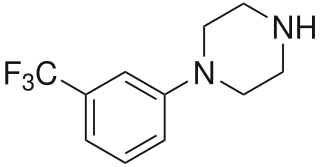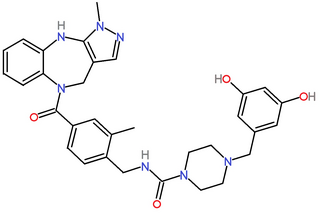Related Research Articles

3,4-Methyl

Oxytocin is a peptide hormone and neuropeptide normally produced in the hypothalamus and released by the posterior pituitary. It plays a role in social bonding, reproduction, childbirth, and the period after childbirth. Oxytocin is released into the bloodstream as a hormone in response to sexual activity and during labour. It is also available in pharmaceutical form. In either form, oxytocin stimulates uterine contractions to speed up the process of childbirth. In its natural form, it also plays a role in bonding with the baby and milk production. Production and secretion of oxytocin is controlled by a positive feedback mechanism, where its initial release stimulates production and release of further oxytocin. For example, when oxytocin is released during a contraction of the uterus at the start of childbirth, this stimulates production and release of more oxytocin and an increase in the intensity and frequency of contractions. This process compounds in intensity and frequency and continues until the triggering activity ceases. A similar process takes place during lactation and during sexual activity.

3,4-Methylenedioxyamphetamine is an empathogen-entactogen, psychostimulant, and psychedelic drug of the amphetamine family that is encountered mainly as a recreational drug. In terms of pharmacology, MDA acts most importantly as a serotonin–norepinephrine–dopamine releasing agent (SNDRA). In most countries, the drug is a controlled substance and its possession and sale are illegal.

5-HT receptors, 5-hydroxytryptamine receptors, or serotonin receptors, are a group of G protein-coupled receptor and ligand-gated ion channels found in the central and peripheral nervous systems. They mediate both excitatory and inhibitory neurotransmission. The serotonin receptors are activated by the neurotransmitter serotonin, which acts as their natural ligand.

3-Trifluoromethylphenylpiperazine (TFMPP) is a recreational drug of the piperazine chemical class. Usually in combination with benzylpiperazine (BZP) and other analogues, it is sold as an alternative to the illicit drug MDMA ("Ecstasy").

Vasopressin V1b receptor (V1BR) also known as vasopressin 3 receptor (VPR3) or antidiuretic hormone receptor 1B is a protein that in humans is encoded by the AVPR1B gene.

A serotonin receptor agonist is an agonist of one or more serotonin receptors. They activate serotonin receptors in a manner similar to that of serotonin, a neurotransmitter and hormone and the endogenous ligand of the serotonin receptors.

meta-Chlorophenylpiperazine (mCPP) is a psychoactive drug of the phenylpiperazine class. It was initially developed in the late-1970s and used in scientific research before being sold as a designer drug in the mid-2000s. It has been detected in pills touted as legal alternatives to illicit stimulants in New Zealand and pills sold as "ecstasy" in Europe and the United States.
Cardiac fibrosis commonly refers to the excess deposition of extracellular matrix in the cardiac muscle, but the term may also refer to an abnormal thickening of the heart valves due to inappropriate proliferation of cardiac fibroblasts. Fibrotic cardiac muscle is stiffer and less compliant and is seen in the progression to heart failure. The description below focuses on a specific mechanism of valvular pathology but there are other causes of valve pathology and fibrosis of the cardiac muscle.

The oxytocin receptor, also known as OXTR, is a protein which functions as receptor for the hormone and neurotransmitter oxytocin. In humans, the oxytocin receptor is encoded by the OXTR gene which has been localized to human chromosome 3p25.

Naphthylaminopropane (PAL-287) is an experimental drug under investigation as of 2007 for the treatment of alcohol and stimulant addiction.

The serotonin 1A receptor is a subtype of serotonin receptor, or 5-HT receptor, that binds serotonin, also known as 5-HT, a neurotransmitter. 5-HT1A is expressed in the brain, spleen, and neonatal kidney. It is a G protein-coupled receptor (GPCR), coupled to the Gi protein, and its activation in the brain mediates hyperpolarisation and reduction of firing rate of the postsynaptic neuron. In humans, the serotonin 1A receptor is encoded by the HTR1A gene.

8-OH-DPAT is a research chemical of the aminotetralin chemical class which was developed in the 1980s and has been widely used to study the function of the 5-HT1A receptor. It was one of the first major 5-HT1A receptor full agonists to be discovered.

5-Hydroxytryptamine receptor 2B (5-HT2B) also known as serotonin receptor 2B is a protein that in humans is encoded by the HTR2B gene. 5-HT2B is a member of the 5-HT2 receptor family that binds the neurotransmitter serotonin (5-hydroxytryptamine, 5-HT).

WAY-267464 is a potent, selective, non-peptide agonist for the oxytocin receptor, with negligible affinity for the vasopressin receptors. Contradictorily however, though originally described as selective for the oxytocin receptor and lacking affinity for the vasopressin receptors, it has since been reported to also act as a potent vasopressin V1A receptor antagonist. WAY-267464 has been shown to cross the blood-brain-barrier to a significantly greater extent than exogenously applied oxytocin, and in animal tests produces centrally-mediated oxytocinergic actions such as anxiolytic effects, but with no antidepressant effect evident. It was developed by a team at Ferring Pharmaceuticals.
Osemozotan (MKC-242) is a selective 5-HT1A receptor agonist with some functional selectivity, acting as a full agonist at presynaptic and a partial agonist at postsynaptic 5-HT1A receptors. 5-HT1A receptor stimulation influences the release of various neurotransmitters including serotonin, dopamine, norepinephrine, and acetylcholine. 5-HT1A receptors are inhibitory G protein-coupled receptor. Osemozotan has antidepressant, anxiolytic, antiobsessional, serenic, and analgesic effects in animal studies, and is used to investigate the role of 5-HT1A receptors in modulating the release of dopamine and serotonin in the brain, and their involvement in addiction to abused stimulants such as cocaine and methamphetamine.

U-69,593 is a drug which acts as a potent and selective κ1-opioid receptor agonist. In animal studies it has been shown to produce antinociception, anti-inflammation, anxiolysis, respiratory depression, and diuresis, while having little effect on gastrointestinal motility. It also inhibits the peripheral, though not central secretion of oxytocin and vasopressin in rats.

UWA-101 is a phenethylamine derivative invented by Dr Matthew Piggott at the University of Western Australia, and researched as a potential treatment for Parkinson's disease. Its chemical structure is very similar to that of the illegal drug MDMA, the only difference being the replacement of the α-methyl group with an α-cyclopropyl group. MDMA has been found in animal studies and reported in unauthorised human self-experiments to be effective in the short-term relief of side-effects of Parkinson's disease therapy, most notably levodopa-induced dyskinesia. However the illegal status of MDMA and concerns about its potential for recreational use, neurotoxicity and potentially dangerous side effects mean that it is unlikely to be investigated for medical use in this application, and so alternative analogues were investigated.

MDMA-assisted psychotherapy is the use of prescribed doses of MDMA as an adjunct to psychotherapy sessions. Research suggests that MDMA-assisted psychotherapy for post-traumatic stress disorder (PTSD), including Complex PTSD, might improve treatment effectiveness. In 2017, a Phase II clinical trial led to "breakthrough therapy" designation by the US Food and Drug Administration (FDA).
References
- ↑ Olivier, Berend; Mos, Jan (10 July 1986). Chan, Derwin K.C. (ed.). "Serenics and aggression". Stress & Health. Arlington, Virginia, United States of America: Wiley. 2 (3): 197–209. doi:10.1002/smi.2460020305. ISSN 1532-2998.
- ↑ Bedi, Gillinder; Hyman, David; de Wit, Harriet (December 2010). Krystal, John H. (ed.). "Is ecstasy an "empathogen"? Effects of ±3,4-methylenedioxymethamphetamine on prosocial feelings and identification of emotional states in others". Biological Psychiatry. Brentwood, Tennessee, United States of America: Society of Biological Psychiatry. 68 (12): 1134–1140. doi:10.1016/j.biopsych.2010.08.003. ISSN 0006-3223. LCCN 78009779. OCLC 424038458. PMC 2997873 . PMID 20947066.
- 1 2 Hysek, Cédrik M.; Schmid, Yasmin; Simmler, Linda D.; Domes, Gregor; Heinrichs, Markus; Eisenegger, Christoph; Preller, Katrin H.; Quednow, Boris B.; Liechti, Matthias E. (28 October 2013). Lieberman, Matthew D. (ed.). "MDMA enhances emotional empathy and prosocial behavior". Social Cognitive and Affective Neuroscience. Oxford University Press. 9 (11): 1645–1652. doi:10.1093/scan/nst161. ISSN 1749-5016. PMC 4221206 . PMID 24097374.
- ↑ Cami J, Farré M, Mas M, et al. (August 2000). "Human pharmacology of 3,4-methylenedioxymethamphetamine ("ecstasy"): psychomotor performance and subjective effects". J Clin Psychopharmacol. 20 (4): 455–66. doi:10.1097/00004714-200008000-00010. PMID 10917407.
- ↑ Piper, Brian J.; Fraiman, Joseph B.; Owens, Cullen B.; Ali, Syed F.; Meyer, Jerrold S. (1 April 2008). Carlezon, William A.; George, Tony P.; Neumaier, John F. (eds.). "Dissociation of the neurochemical and behavioral toxicology of MDMA ('Ecstasy') by citalopram". Neuropsychopharmacology . Brentwood, Tennessee, United States of America: American College of Neuropsychopharmacology (ACNP). 33 (5): 1192–1205. doi: 10.1038/sj.npp.1301491 . PMID 17609680.
- ↑ Dumont, C.J.H.; Sweep, F.C.G.; van der Steen, R.; Hermsen, R.; Donders, A.R.T.; Touw, D.J.; van Gerven, J.M.A.; van Gerven, M.A.; Buitelaar, J.K.; Verkes, R.J. (2009). Eslinger, Paul; Boggio, Paulo Sérgio; Young, Larry; Zahn, Roland (eds.). "Increased oxytocin concentrations and prosocial feelings in humans after ecstasy (3,4-methylenedioxymethamphetamine) administration". Social Neuroscience . London, United Kingdom of Great Britain: Society for Social Neuroscience/Taylor & Francis. 4 (4): 359–366. doi:10.1080/17470910802649470. ISSN 1747-0919. LCCN 2006244001. OCLC 69984013. PMID 19562632. S2CID 12310995.
- ↑ Broadbear, Jillian H.; Kabel, D.; Tracy, L.; Mak, P. (1 April 2014). Koob, George F.; Schulteis, Gery; Kantak, Kathleen M.; Arends, Michael A.; Buisman-Pijlman, Femke T.A.; Broadbear, Jillian H.; Sarnyai, Zoltán (eds.). "Oxytocinergic regulation of endogenous as well as drug-induced mood". Pharmacology Biochemistry and Behavior . Amsterdam, Netherlands: Elsevier. 119 (1): 61–71. doi:10.1016/j.pbb.2013.07.002. ISSN 0091-3057. LCCN 73644949. OCLC 1787728. PMID 23872370. S2CID 19772247 . Retrieved 6 August 2021.
- ↑ de Boer, Sietse F.; Koolhaas, Jaap M. (1 December 2005). Redegeld, Frank A.; Verri, Waldiceu A.; Burk, Josh (eds.). "5-HT1A and 5-HT1B receptor agonists and aggression: A pharmacological challenge of the serotonin deficiency hypothesis". European Journal of Pharmacology . Amsterdam, Netherlands: Elsevier. 526 (1–3): 125–139. doi:10.1016/j.ejphar.2005.09.065. ISSN 0014-2999. LCCN sf97001017. OCLC 01568459. PMID 16310183 . Retrieved 6 August 2021.
- ↑ Olivier, Berend (10 December 2004). "Serotonin and Aggression". Annals of the New York Academy of Sciences. New York City, New York, United States of America: New York Academy of Sciences. 1036 (1): 382–392. Bibcode:2004NYASA1036..382O. doi:10.1196/annals.1330.022. ISSN 0077-8923. LCCN 12037287. OCLC 01306678. PMID 15817750. S2CID 45595253 . Retrieved 6 August 2021.
- ↑ Calcagnoli, Federica; de Boer, Sietse F.; Althaus, Monika; den Boer, Johan A.; Koolhaas, Jaap M. (October 2013). de Witt, Harriet; Curran, Valerie H.; Morrow, A. Leslie; Hashimoto, Kenji; Howes, Oliver; Floresco, Stan B.; D'Souza, Deepak (eds.). "Antiaggressive activity of central oxytocin in male rats". Psychopharmacology . Geneva, Switzerland: European Behavioural Pharmacology Society (EBPS)/Springer. 229 (4): 639–651. doi:10.1007/s00213-013-3124-7. PMID 23624810. S2CID 481042.
- ↑ Ferris, Craig F.; Lu, Shi-fang; Messenger, Tara; Guillon, Christophe D.; Heindel, Ned; Miller, Marvin; Koppel, Gary; Bruns, F. Robert; Simon, Neal G. (1 February 2006). Griebel, G.; Arends, M.A.; Izenwasser, S. (eds.). "Orally active vasopressin V1a receptor antagonist, SRX251, selectively blocks aggressive behavior". Pharmacology Biochemistry and Behavior. Amsterdam, Netherlands. 83 (2): 169–174. doi:10.1016/j.pbb.2006.01.001. ISSN 0091-3057. OCLC 67271683. PMID 16504276. S2CID 24199104.
- ↑ Pinna, Graziano; Agis-Balboa, Roberto Carlos; Pibiri, Fabio; Nelson, Marianela; Guidotti, Alessandro; Costa, Erminio (13 May 2008). Schousboe, Arne (ed.). "Neurosteroid biosynthesis regulates sexually dimorphic fear and aggressive behavior in mice". Neurochemical Research. Geneva, Switzerland: Springer. 33 (10): 1990–2007. doi:10.1007/s11064-008-9718-5. ISSN 0364-3190. PMID 18473173. S2CID 19338424 . Retrieved 6 August 2021.
- 1 2 Fabio, Karine M.; Guillon, Christophe D.; Lu, Shi-Fang; Heindel, Ned D.; Brownstein, Michael J.; Lacey, Carl J.; Garippa, Carrie; Simon, Neal G. (2013). "Pharmacokinetics and Metabolism of SRX246: A Potent and Selective Vasopressin 1a Antagonist". Journal of Pharmaceutical Sciences. Amsterdam, Netherlands: Elsevier. 102 (6): 2033–2043. doi:10.1002/jps.23495. ISSN 0022-3549. PMID 23471831.
- ↑ Simon, Neal G. (5 May 2020). Rutter, Joni L. (ed.). "Developing SRX246 for Stress-Related Affective Illness". National Center for Advancing Translational Sciences (NCATS) . Bethesda, Maryland, United States of America: National Institutes of Health . Retrieved 6 August 2021.
- ↑ Verhoeven, Willem M.A.; Tuinier, Sigfried (15 August 2007). Marazziti, Donatella; Schimmenti, Adriano (eds.). "Serenics: Anti-aggression drugs throughout history" (PDF). Clinical Neuropsychiatry: Journal of Treatments Evaluation. Rome, Italy: Giovanni Fioriti Editore. 4 (4): 135–143. ISSN 1724-4935 . Retrieved 6 August 2021.